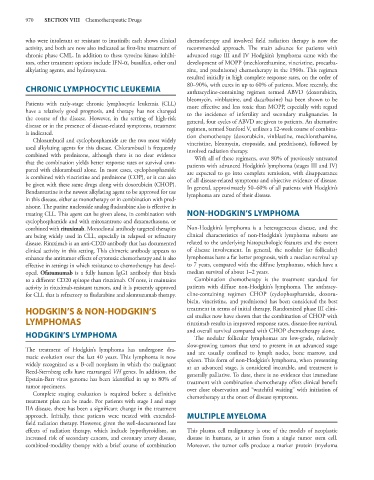Page 984 - Basic _ Clinical Pharmacology ( PDFDrive )
P. 984
970 SECTION VIII Chemotherapeutic Drugs
who were intolerant or resistant to imatinib; each shows clinical chemotherapy and involved field radiation therapy is now the
activity, and both are now also indicated as first-line treatment of recommended approach. The main advance for patients with
chronic phase CML. In addition to these tyrosine kinase inhibi- advanced stage III and IV Hodgkin’s lymphoma came with the
tors, other treatment options include IFN-α, busulfan, other oral development of MOPP (mechlorethamine, vincristine, procarba-
alkylating agents, and hydroxyurea. zine, and prednisone) chemotherapy in the 1960s. This regimen
resulted initially in high complete response rates, on the order of
CHRONIC LYMPHOCYTIC LEUKEMIA 80–90%, with cures in up to 60% of patients. More recently, the
anthracycline-containing regimen termed ABVD (doxorubicin,
bleomycin, vinblastine, and dacarbazine) has been shown to be
Patients with early-stage chronic lymphocytic leukemia (CLL) more effective and less toxic than MOPP, especially with regard
have a relatively good prognosis, and therapy has not changed to the incidence of infertility and secondary malignancies. In
the course of the disease. However, in the setting of high-risk general, four cycles of ABVD are given to patients. An alternative
disease or in the presence of disease-related symptoms, treatment regimen, termed Stanford V, utilizes a 12-week course of combina-
is indicated. tion chemotherapy (doxorubicin, vinblastine, mechlorethamine,
Chlorambucil and cyclophosphamide are the two most widely vincristine, bleomycin, etoposide, and prednisone), followed by
used alkylating agents for this disease. Chlorambucil is frequently involved radiation therapy.
combined with prednisone, although there is no clear evidence With all of these regimens, over 80% of previously untreated
that the combination yields better response rates or survival com- patients with advanced Hodgkin’s lymphoma (stages III and IV)
pared with chlorambucil alone. In most cases, cyclophosphamide are expected to go into complete remission, with disappearance
is combined with vincristine and prednisone (COP), or it can also of all disease-related symptoms and objective evidence of disease.
be given with these same drugs along with doxorubicin (CHOP). In general, approximately 50–60% of all patients with Hodgkin’s
Bendamustine is the newest alkylating agent to be approved for use lymphoma are cured of their disease.
in this disease, either as monotherapy or in combination with pred-
nisone. The purine nucleoside analog fludarabine also is effective in
treating CLL. This agent can be given alone, in combination with NON-HODGKIN’S LYMPHOMA
cyclophosphamide and with mitoxantrone and dexamethasone, or
combined with rituximab. Monoclonal antibody targeted therapies Non-Hodgkin’s lymphoma is a heterogeneous disease, and the
are being widely used in CLL, especially in relapsed or refractory clinical characteristics of non-Hodgkin’s lymphoma subsets are
disease. Rituximab is an anti-CD20 antibody that has documented related to the underlying histopathologic features and the extent
clinical activity in this setting. This chimeric antibody appears to of disease involvement. In general, the nodular (or follicular)
enhance the antitumor effects of cytotoxic chemotherapy and is also lymphomas have a far better prognosis, with a median survival up
effective in settings in which resistance to chemotherapy has devel- to 7 years, compared with the diffuse lymphomas, which have a
oped. Ofatumumab is a fully human IgG1 antibody that binds median survival of about 1–2 years.
to a different CD20 epitope than rituximab. Of note, it maintains Combination chemotherapy is the treatment standard for
activity in rituximab-resistant tumors, and it is presently approved patients with diffuse non-Hodgkin’s lymphoma. The anthracy-
for CLL that is refractory to fludarabine and alemtuzumab therapy. cline-containing regimen CHOP (cyclophosphamide, doxoru-
bicin, vincristine, and prednisone) has been considered the best
HODGKIN’S & NON-HODGKIN’S treatment in terms of initial therapy. Randomized phase III clini-
cal studies now have shown that the combination of CHOP with
LYMPHOMAS rituximab results in improved response rates, disease-free survival,
HODGKIN’S LYMPHOMA and overall survival compared with CHOP chemotherapy alone.
The nodular follicular lymphomas are low-grade, relatively
slow-growing tumors that tend to present in an advanced stage
The treatment of Hodgkin’s lymphoma has undergone dra- and are usually confined to lymph nodes, bone marrow, and
matic evolution over the last 40 years. This lymphoma is now spleen. This form of non-Hodgkin’s lymphoma, when presenting
widely recognized as a B-cell neoplasm in which the malignant at an advanced stage, is considered incurable, and treatment is
Reed-Sternberg cells have rearranged VH genes. In addition, the generally palliative. To date, there is no evidence that immediate
Epstein-Barr virus genome has been identified in up to 80% of treatment with combination chemotherapy offers clinical benefit
tumor specimens. over close observation and “watchful waiting” with initiation of
Complete staging evaluation is required before a definitive
treatment plan can be made. For patients with stage I and stage chemotherapy at the onset of disease symptoms.
IIA disease, there has been a significant change in the treatment
approach. Initially, these patients were treated with extended- MULTIPLE MYELOMA
field radiation therapy. However, given the well-documented late
effects of radiation therapy, which include hypothyroidism, an This plasma cell malignancy is one of the models of neoplastic
increased risk of secondary cancers, and coronary artery disease, disease in humans, as it arises from a single tumor stem cell.
combined-modality therapy with a brief course of combination Moreover, the tumor cells produce a marker protein (myeloma

